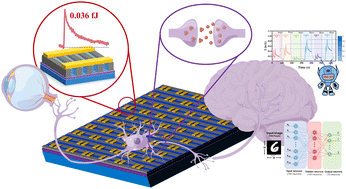Ultralow-power consumption photonic synapse transistors based on organic array films fabricated using a particular prepatterned-guided crystallizing strategy†
Abstract
Artificial photonic synapses, owing to their high sensitivity, low power consumption, and integration of sensing and memory, have aroused comprehensive discussion and have been developed into devices used as the new sensors for the Internet of Things (IoT) and artificial neural networks (ANNs). Colossal energy consumption may be one of the factors hindering the development of neuromorphic computing. Herein, ternary component organic array films of TIPS-pentacene, polystyrene, and CsPbBr3 perovskite quantum dots (QDs) are effectively developed to fabricate photonic synaptic transistors. The patterned organic thin films prepared by the solution processes can be distinctly controlled in the crystallographic orientation using a pre-patterned-guided crystallizing strategy and the corresponding transistor of TIPS-pentacene with mobility over 1 cm2 V−1 s−1 is successfully achieved. On this basis, the ternary composite film exhibits synaptic behaviours from short-term plasticity (STP) to long-term plasticity (LTP), including paired-pulse facilitation (PPF), spike-time-dependent plasticity (STDP), spike-number-dependent plasticity (SNDP), spike-frequency dependent plasticity (SFDP) and light-potentiation/electric-depression. Benefiting from the improved material compatibility and film-forming properties of small molecule semiconductors and perovskite QDs with polymer polystyrene, our synapses still exhibit prominent synaptic features at a low power consumption of 0.036 fJ. Utilizing time-dependent plasticity, the synaptic device stimulated by a series of light signals realizes wireless optical communication. In addition, the pattern recognition function by ANNs is verified. This work provides a feasible fabricating path to patterned array film-based photonic synapses for the next generation human–computer interaction sensors.

- This article is part of the themed collection: 2023 Journal of Materials Chemistry C HOT Papers


 Please wait while we load your content...
Please wait while we load your content...